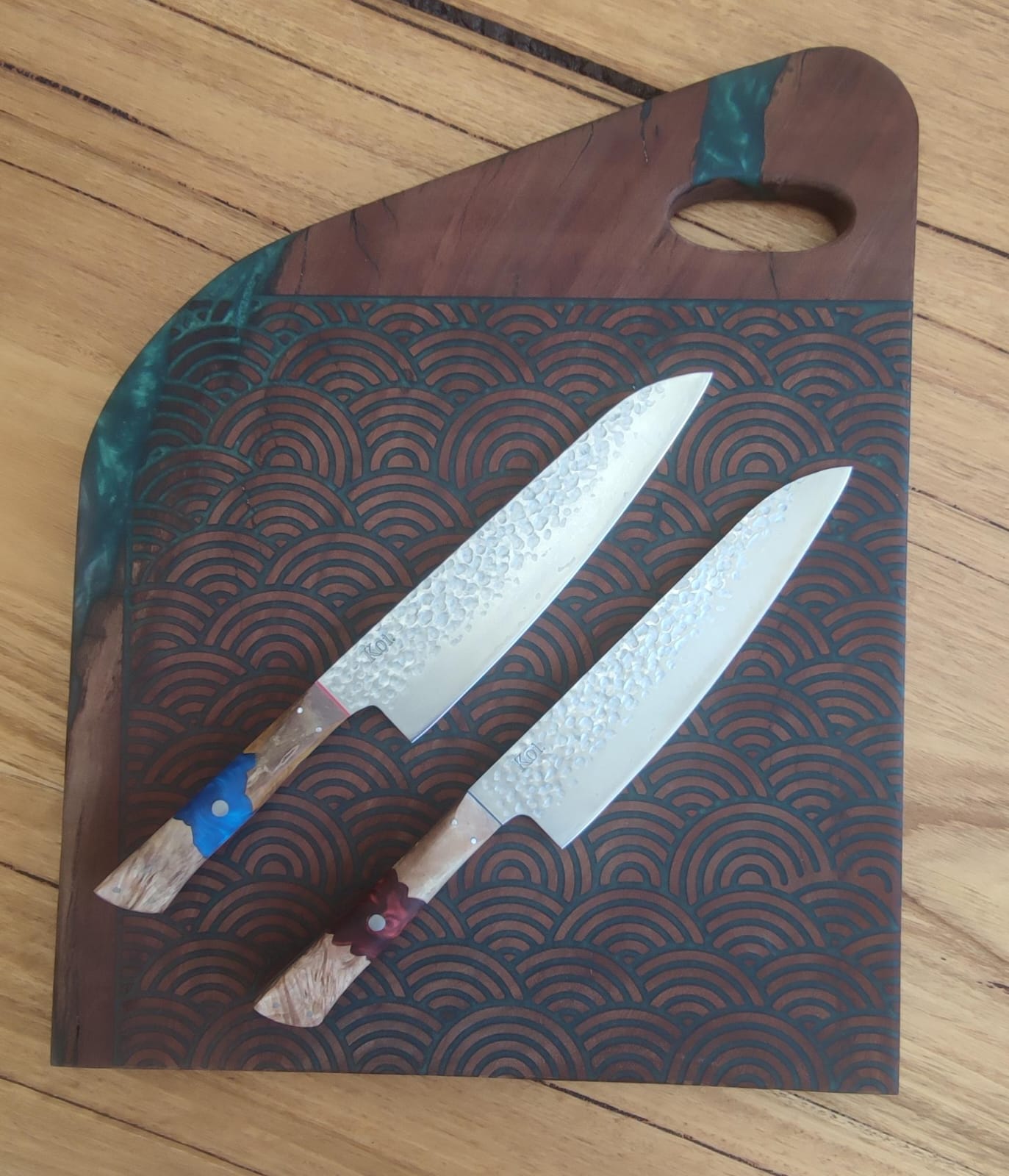Are you confused about all the kitchen knives?
Mastering the art of cooking begins with knowing your tools. Japanese knives offer a universe of possibilities in blade style, steel, and length. Whether on a budget or aiming for top-notch quality, these blades cater to diverse needs.
Explore the world of Japanese knives with us as we break down the must-haves for kitchen enthusiasts.
A Blade for Every Culinary Task
Japanese knives boast various shapes, designs, and materials, making them versatile tools catering to diverse culinary needs. This culinary arsenal includes the Santoku, Bunka, and Gyuto knives, each excelling in specific tasks.
Blade Variety
- Santoku, Bunka, Gyuto: Versatile choices for everyday use.
- Shapes and Designs: Unique profiles cater to specific tasks.
- Materials: From traditional to modern alloys, catering to various preferences.
Choosing the Right Blade
Amidst this abundance, a rule of thumb guides your selection:
- Wider Blades: Ideal for efficient vegetable chopping.
- Narrow and Long Blades: Suitable for precise meat cutting, not rapid chopping.
- Short and Narrow Blades: Perfect for free-hand tasks and detailed work.
Decoding Japanese Steel Excellence
Regarding Japanese knives, the choice of steel is a crucial factor influencing sharpness and durability.
Stainless Steels: Low Maintenance for Fast-Paced Kitchens
- Ideal for Everyday Use: With rust resistance, stainless steels are perfect for kitchens with a brisk pace.
- Everyday Durability: These steels shine in environments where constant wiping and maintenance might not be feasible.
Powder Steels: Sharpness and Durability
- Choice of Professionals: Loved by chefs for their exceptional sharpness and durability.
- Cutting Power: Powder steels exhibit outstanding cutting power, ideal for precision in professional kitchens.
Carbon Steels: Incredibly Sharp Edge with Maintenance Caution
- Unmatched Sharpness: For those desiring the sharpest edge possible, carbon steels deliver.
- Maintenance Caution: Require careful upkeep due to susceptibility to corrosion.
Choose your steel wisely, aligning it with the demands of your kitchen, ensuring a perfect blend of performance and longevity.
Anatomy of a Japanese Blade
Japanese blades are a testament to craftsmanship, blending layered beauty with exceptional functionality.
Layers of Steel and Damascus Patterns
- Japanese blades often consist of two or more layers of steel, forming a unique Damascus pattern.
- This intricate pattern, reminiscent of beach waves or tree rings, results from detailed layering, creating knives that are not just tools but visual works of art.
Benefits of Laminated Steel Knives
- Laminated steel knives offer a perfect blend of strength and sharpness.
- The hard core ensures prolonged sharpness, while the outer layers provide durability and protection.
- This construction allows for creative forging, resulting in knives with distinct patterns, making each piece truly one-of-a-kind.
Single Bevel vs. Double Bevel: Specialization vs. Versatility
- Single bevel knives, specialized for either left or right-handed users, excel in specific tasks like vegetable preparation or fish filleting.
- Double bevel knives, with a blade ground on both sides, offer versatility, suitable for a wide range of kitchen activities.
The Precision of Japanese Sharpness
Japanese knives epitomize precision, boasting sharper, thinner, and finer blades. The essence of this precision lies in meticulous manufacturing techniques:
- Manufacturing Excellence: Crafted with centuries-old techniques, Japanese knives achieve unparalleled precision in their cutting edge.
- Minimal Cell Membrane Damage: The design ensures minimal damage to food cell membranes, preserving flavors with the utmost finesse.
- Careful Handling for Longevity: To maintain this precision, careful handling is paramount. With their exceptional sharpness, Japanese knives thrive with proper care, promising longevity.
Why Own a Japanese Knife?
Japanese knives go beyond kitchen tools; they're a profound homage to tradition, art, and expert craftsmanship.
Tribute to Tradition, Art, and Craftsmanship
These knives embody the essence of kodawari, the Japanese pursuit of perfection in all aspects. Crafted with creativity and precision, they showcase Damascus patterns, hammer impressions (tsuchime), and delicate kasum lines, reflecting the depth of Japanese culture.
Evolution Alongside Modern Technology
While preserving ancient techniques, Japanese knives evolve with modern trends, marrying tradition with technological advancements for unparalleled quality and durability.
Preserving and Respecting the Craft of Japanese Knife-Making
Owning a Japanese knife means participating in the preservation and respect for the centuries-old craft of Japanese knife-making.
Showcasing Signature Knives
Koi's collection is a testament to Japanese knives' artistry and functionality.
Gyuto: The Iconic Chef's Knife
Historical Significance
Evolving from the traditional Japanese chef's knife, the Gyuto embodies history and modern craftsmanship. This blade pays homage to heritage with a nuanced touch.
Specifications
Crafted from AUS10 67-layer Damascus Japanese steel, the Gyuto boasts a blade length of 210mm, an overall length of 360mm, and a blade thickness of 2.8mm. Weighing at 205g with an HRC of 58-60, it's a masterpiece of balance.
Craftsmanship
The Gyuto's craftsmanship extends to its Australian hardwood handle, sourced from McLaren Vale. This thoughtful touch adds a unique aesthetic and ergonomic appeal.
Santoku: The All-Rounder
Features and Design
Renowned as Japan's second most popular knife, the Santoku seamlessly blends beauty with functionality. Crafted with AUS10 67-layer Damascus Japanese steel, it's a testament to Japanese precision.
Ninja Collection Variation
The Ninja Collection's Santoku boasts a full-tang steel handle, ensuring robustness. With a blade length of 210mm, overall length of 360mm, blade thickness of 2.2mm, weight of 226g, and HRC of 60-61, it's a powerhouse in both form and function.
Wallaby: The Australian Touch
Unique Features
The Wallaby, a smaller cousin to the Kangaroo, brings an Australian touch. VG10 high carbon Japanese steel with a sandblast finish ensures strength and aesthetic appeal.
Forced Patina Finish option
While the Wallaby in the Big Red Collection has a wood and resin handle, sourced from Australian burls like Gidgee, mirror the diverse landscapes of the Australian outback. The Patina Wallaby has a solid G10 handle, ideal for commercial kitchens and a forced patina finish on the blade.
Dingo: All-Purpose Power
Origin and Distinctive Features
Inspired by the Australian outback wild dog, the Dingo symbolises power. Crafted from VG10 high carbon Japanese steel with the options of a forced patina acid wash, or a sandblasted finish, it balances durability with a unique aesthetic.
Powerful Design
Specifications include a blade length of 200mm, overall length of 336mm, blade thickness of 3mm, weight of 290g, and HRC of 60-62, making it a versatile tool for various cutting tasks.
Handle Variations
Partial Tang vs. Full Tang: A Distinctive Choice
The Gyuto's Australian hardwood handle showcases a partial tang design, balancing aesthetics and functionality. In contrast, the Santoku in the Ninja Collection features a full-tang steel handle for enhanced robustness during culinary tasks.
Partial Tang Elegance: Gyuto's Unique Appeal
With a sleek, visually appealing partial tang design, the Gyuto's handle seamlessly integrates with the blade. This design provides a nimble and precise grip, ideal for culinary finesse.
Full Tang Dominance: Santoku's Power Play
Contrastingly, the full-tang handle of the Santoku extends throughout the grip, enhancing durability and control. This design choice caters to chefs who prefer a more substantial feel in their knives.




